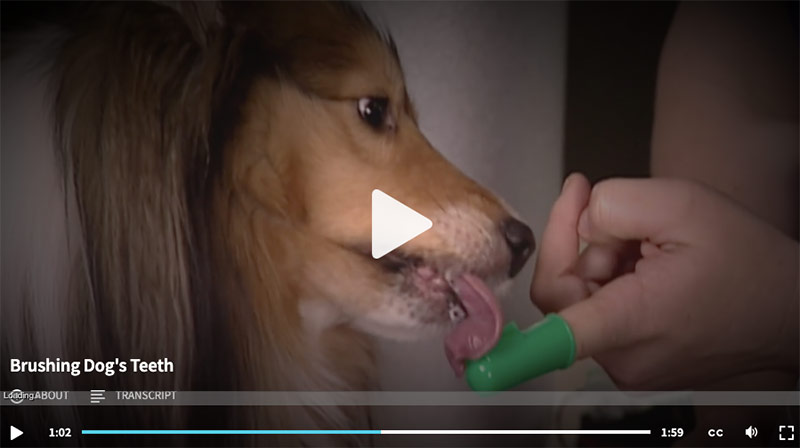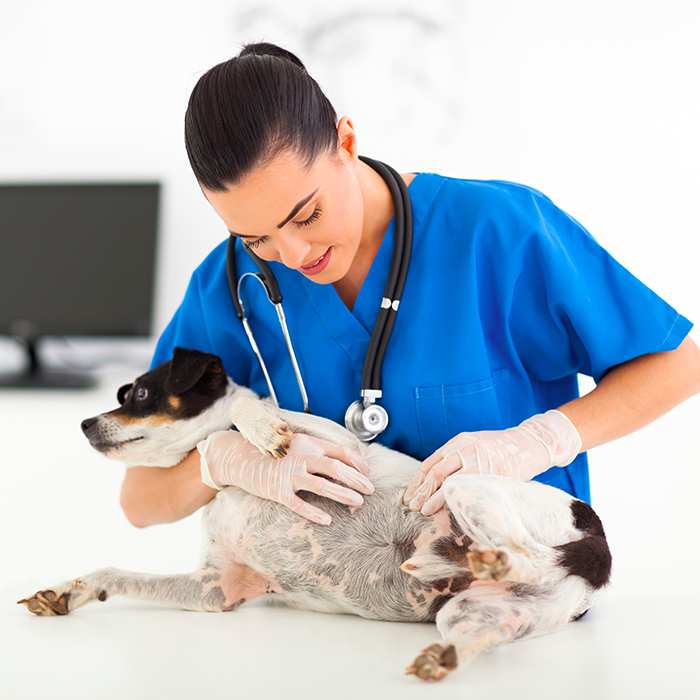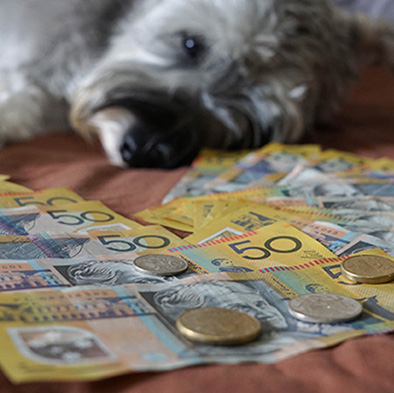Guide to brushing your dog’s teeth effectively
We all know how important it is for our own dental health to brush our teeth twice a day. But did you know that brushing your dog’s teeth is as important for their oral hygiene as it is for our own? While it is ideal to begin when your dog is young, it is never too late to start caring for your dog’s teeth.
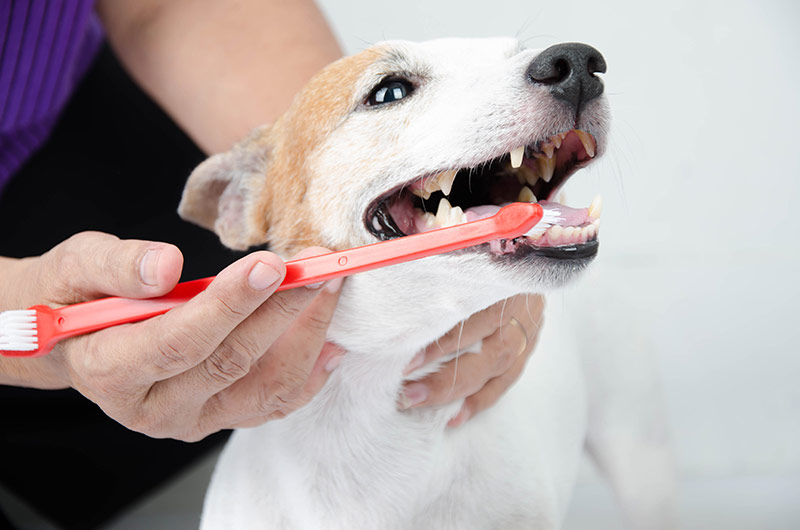
The benefits of brushing your dog’s teeth
The key to maintaining good oral health – for us and our pets – is prevention. Without regular brushing, plaque and tartar will build up in our dogs’ mouths the same way that they do in our own, causing dental problems like inflamed gums, bad breath, tooth decay and painful infections. Severe dental infection can spread to other parts of the body, sometimes causing life-threatening conditions.
Good dental care is an essential element of your dog’s long-term health and happiness, and the importance of regularly brushing your dog’s teeth should not be underestimated. When the surfaces of the teeth are cleaned frequently, the gums stay healthy and the risk of dental disease and infections is significantly reduced.
How often should I brush my dog’s teeth?
Vets recommend daily brushing for optimal oral hygiene – some even suggest that twice per day is best. If you can commit to daily brushing, you will be doing your dog a huge favour in the long run. While the gold standard is daily brushing, if her mouth is healthy, even three times a week can make a difference. Brushing once per month, or even once per week, is not considered to be enough. You don’t need to brush every day at first – while your dog is getting used to the experience, aim to build up to daily brushing if achievable.
What toothbrush should I use?
You can buy a toothbrush designed especially for dogs, with softer, specially angled bristles, from most pet stores. There are even electric doggie-toothbrushes which have the advantage of getting the job done more quickly and efficiently, but be aware that many dogs don’t like the noise and vibrations these make. It is usually best to start with a manual brush and only move to an electric model when your dog is completely comfortable with having her teeth brushed.
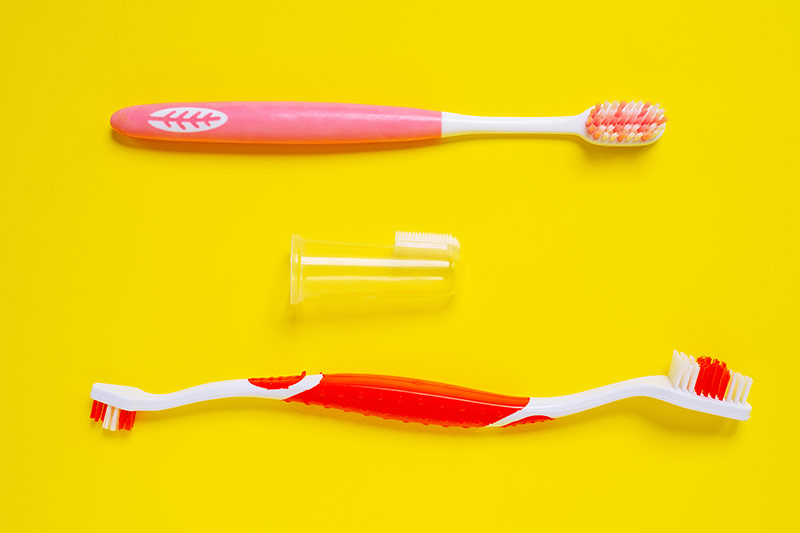
If you have a large dog, choose a brush with a long handle to get better reach to the back teeth. While not designed specifically for dogs, human toothbrushes with soft bristles can be used for smaller dogs. A finger-brush can be useful to start off with. Finger brushes (pictured below) are another option that many owners find easier to use and dogs more willingly accept.
What toothpaste should I use?
You will need to purchase a dog toothpaste – these come in dog-friendly flavours like beef, chicken and peanut butter. Dog toothpastes differ in their active and inactive ingredients, and some might work better – and taste better – for your dog than others. Experiment with different brands and flavours until you find one that your dog likes – hopefully, she will see it as a treat. If she likes the taste and associates it with having her teeth brushed, it will make the experience more positive and enjoyable for her.
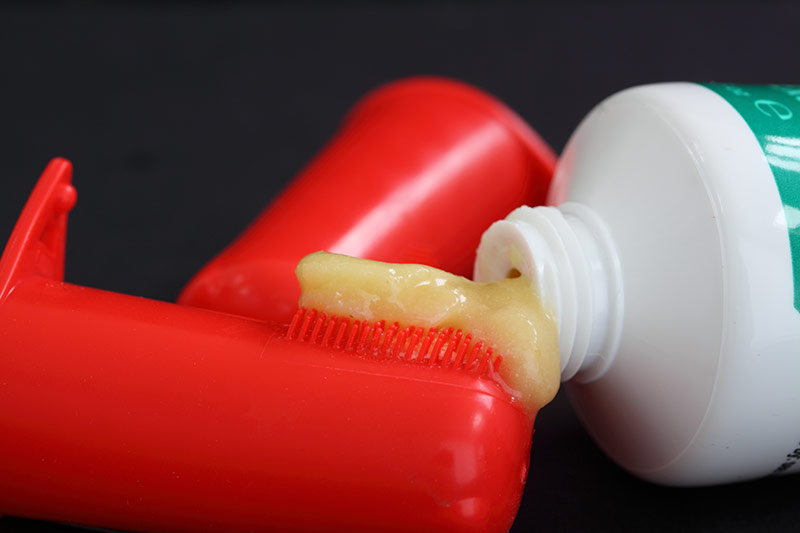
Be aware that human toothpaste is for humans, not for pets. Avoid these completely as they are likely to contain ingredients that can be harmful to dogs, such as fluoride and xylitol. Also try to avoid brands and flavours containing sugar or other sweeteners.
When should I start?
Beginning tooth brushing when your dog is still a puppy is the general recommendation from vets. Brushing the teeth of an adult dog who is not used to this practice can prove difficult. However, it’s never too late to start – it may just be a little more challenging.
The following video will give some guidance as to when and how to start your dog’s tooth brushing:
How long will it take?
Most dogs accept brushing very well if they are introduced to the procedure gradually, in a calm and patient way. The steps below should be performed over a number of days, or even weeks, if need be. Only proceed to the next step if your dog is completely comfortable with the previous one. If she appears resistant or uncomfortable at any step, don’t rush her – you may need to get her comfortable with each step over a few sessions before moving on.
It is important to take your time with the process or else she may become resistant to having her teeth brushed. At any point that she is resisting or becomes aggressive, stop and wait until the next day to try again. Reward her with lots of praise as you carry out each step, and more praise, as well as a dental-friendly treat, at the end of each session. It’s a new experience for your dog and praising and rewarding her will make her more receptive to having her teeth brushed.
Environment and preparation
It’s really important to create a calm environment before starting the brushing process. Choose a quiet, comfortable space with minimal distractions. This will help set a positive tone for the brushing sessions, especially for dogs that might be anxious.
Find the right time of day, when you are not pressed for time and both you and your dog are feeling calm and relaxed. Make sure you’re positioned so that your dog is comfortable, for example, kneeling or sitting in front of or to the side of her. Don’t stand above her, hold her down, or take a threatening stance. Ideally, it should be a fun and enjoyable experience for both of you.
Step-by-step guidance
Step 1:
Gently pet and scratch her muzzle, slowly lifting her upper lip for about 30 seconds.
Step 2:
After lifting her upper lip, lightly rub your finger along her upper gums and teeth for about 30 seconds – this will help her get used to the feel of something against her teeth.
Step 3:
After the above steps, put a small amount of dog toothpaste on your fingertip or finger-toothbrush and let her lick it so that she can get used to the texture and taste (if after a few days she refuses to lick the toothpaste, try a different flavour).
Step 4:
Once she is used to you opening and touching her mouth and you have found a toothpaste she likes, place a small amount of the toothpaste on your finger or a finger-brush, lift her lip and run the brush gently over her teeth for 30 to 60 seconds.
Step 5:
Lift her lip, run your finger or the finger-brush over her teeth for 30 seconds and then gently insert the toothbrush with a small amount of toothpaste into her mouth, and run it lightly over her teeth for up to 30 seconds.
Step 6:
Progress by slowly increasing the time with the toothbrush in her mouth, gradually aiming for two minutes brushing time (one minute on each side). At the same time, slowly increase the pressure until you are gently rubbing her teeth with the brush.
Step 7:
Starting with the outer teeth, using gentle circular motions, gradually work up to more challenging areas like the molars and inner surfaces. Also, it’s very important to brush along the gum line to prevent plaque buildup.
Watch the following video for step by step instructions on how to brush your dog’s teeth:
How to brush your dog’s teeth effectively
Lift her upper lip. As you approach her teeth with the brush, angle the bristles so they reach the gum line. Placing the bristles at a 45-degree angle against her teeth will allow them to massage the gum line and clean away plaque. Brush in small circles, covering the outer surface of the top and bottom teeth on each side. Brush a few teeth at a time, working up to more each day. Aim for two minutes total.
The challenges of teeth-brushing
In an ideal world, brushing your dog’s teeth should not be a negative experience for either of you. Teeth-brushing can and should be a positive experience, where the dog enjoys the extra attention and the owner enjoys spending close quality time with their companion. However, there are many dogs and owners who do not enjoy the act of teeth-brushing, and those who avoid it altogether because of the stress and frustration it causes. If you and your dog are still struggling with teeth-brushing after trying the gradual approach outlined above, contact your vet for more advice.
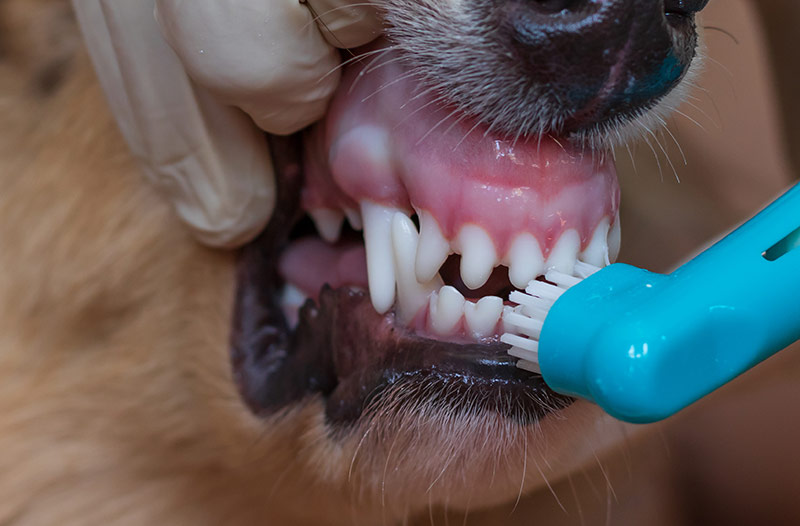
Other challenges many owners face is finding the time to fit teeth-brushing into their busy schedules, and some are resistant to putting their fingers in their pet’s mouth. On top of that, there are not many dogs who will willingly sit still for long enough for their owner to complete the job. If your dog resists having her teeth brushed, or time is an issue, try to at least clean the outsides of the canine and back teeth, where plaque tends to collect. If you can’t get to the inside surfaces, don’t stress – her coarse tongue helps keep that area clean.
While brushing along the gum line, some light bleeding may occur. Slight bleeding every so often is not a cause for concern. However, ongoing or heavy bleeding may indicate that you are brushing too aggressively, or it may be a sign of gum disease. Consult your vet for advice.
Remember to make it a positive experience to maximise your chance of success!
Try to keep the mood light while you’re brushing your dog’s teeth. Talk to her throughout the activity, describing to her exactly what you’re doing. Tell her what a good dog she is and stroke or pat her while you’re brushing. Always stop immediately if the situation becomes stressful or unpleasant. When you’re finished, reward her with her favourite dental friendly treat and lots of extra attention.
Learn more:
Dog dental care – what you need to know
Maintaining your pets’ dental hygiene

